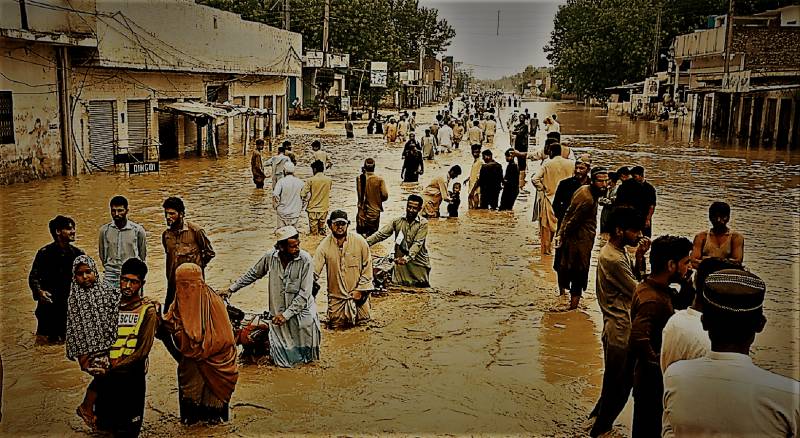
Despite contributing less than 1% to greenhouse gas emissions, Pakistan continues to face extreme weather conditions resulting from the impacts of climate change. After the catastrophic floods of 2022, once again Pakistan suffered heavy torrential rain in Azad Kashmir, Balochistan, Punjab and Khyber Pakhtunkhwa provinces between 12 and 16 April this year, which resulted in 98 deaths and injuries to 89 others.
The 2022 floods ravaged large parts of Pakistan, especially Balochistan and Sindh, causing millions to lose their livelihoods. These floods resulted from unprecedented rainfall and hill torrents: a terrible disaster; the 2022 floods led to an overflow of rivers and caused massive death and destruction. The Post-Disaster Needs Assessment (PDNA) report on the 2022 floods states that, among other things, the floods damaged houses as well as the public administrative buildings of police, judiciary, and prisons. These floods also had detrimental effects on roads, bridges, pipelines and transmission towers, due to which communication was disrupted. The agriculture and energy sectors were massively affected; substantial livestock was killed, and commercial poultry and aquaculture were adversely affected as well. The torrential flooding affected the irrigation system and increased waterlogging.
Climate change-induced disasters have disproportionate gender impacts due to their impact on the more vulnerable communities, increasing the risks of gender-based violence
Such climate-induced floods also have significant impacts on the education sector: the infrastructure of some schools was partially or fully destroyed, as per the PDNA report. Due to a lack of adaptive capacity to compensate flood victims, these schools were converted into temporary shelters for the internally displaced persons. These disasters have disproportionate gender impacts on women, children, and transgenders because they are the more vulnerable communities, and the risks of gender-based violence increases. Gerida Birukila, UNICEF Pakistan’s chief field officer, commented on the situation of the 2022 floods in Balochistan, remarking that “people don’t have food, shelter and required health care”. The officer also raised concerns that people had no choice but to drink contaminated, disease-ridden water. During such floods, water- and vector-borne diseases spread, which need to be mitigated appropriately.
Climate change is a global phenomenon, and tackling it requires collaboration at state, regional and global level. While there is an urgent need to conduct pre-disaster risk assessments through technological tools, now floods are occurring unexpectedly, increasing the importance of proper pre-planning along with the necessary adaptive and mitigation policies by vulnerable countries.
Public awareness is necessary, and it should be undertaken through proper policy guidelines in multiple languages so that the information necessary to avoid and adapt to climate change-induced disasters can reach as many people as possible. The role of media in spreading awareness about climate change and strategies for sustainable development cannot be ignored. Climate change and environmental sustainability subjects should be taught in education curricula at different levels. The 4R’s framework given by New Zealand’s National Emergency Management Agency– reduction, readiness, response and recovery – should be adapted and implemented by Pakistan as well.
As per the Sendai framework, Pakistan’s disaster management bodies – National Disaster Management Authority (NDMA), Provincial Disaster Management Authorities (PDMA), and District Disaster Management Authorities (DDMA) – should be strengthened and their roles during different phases of disasters should be clearly defined. These institutions have capacity, but the main issue they face is a lack of funding, which is a major hurdle in every development project in Pakistan. These organisations must also focus on allocation of necessary expertise, through the hiring of personnel with relevant degrees and work experience in fields related to environment and climate change.
Countries vulnerable to climate change must plan accordingly, conduct pre-disaster risk assessments, and institute adaptive and mitigation policies forthwith
Climate change also poses a serious non-traditional security threat, challenging all previous conceptions of security promoted by traditionalists and mercantilists. Climate-induced disasters have the capacity to become serious national security issues because they intensify socio-economic deprivation and potentially trigger marginalised communities as they are further pushed below the poverty line.
The frequency and magnitude of these disasters are a dreadful reminder that the planet needs to be saved for our coming generations. As World Bank CEO Kristalina Georgieva said, “We are clearly the last generation that can change the course of climate change, but we are also the first generation to feel its impacts”.

